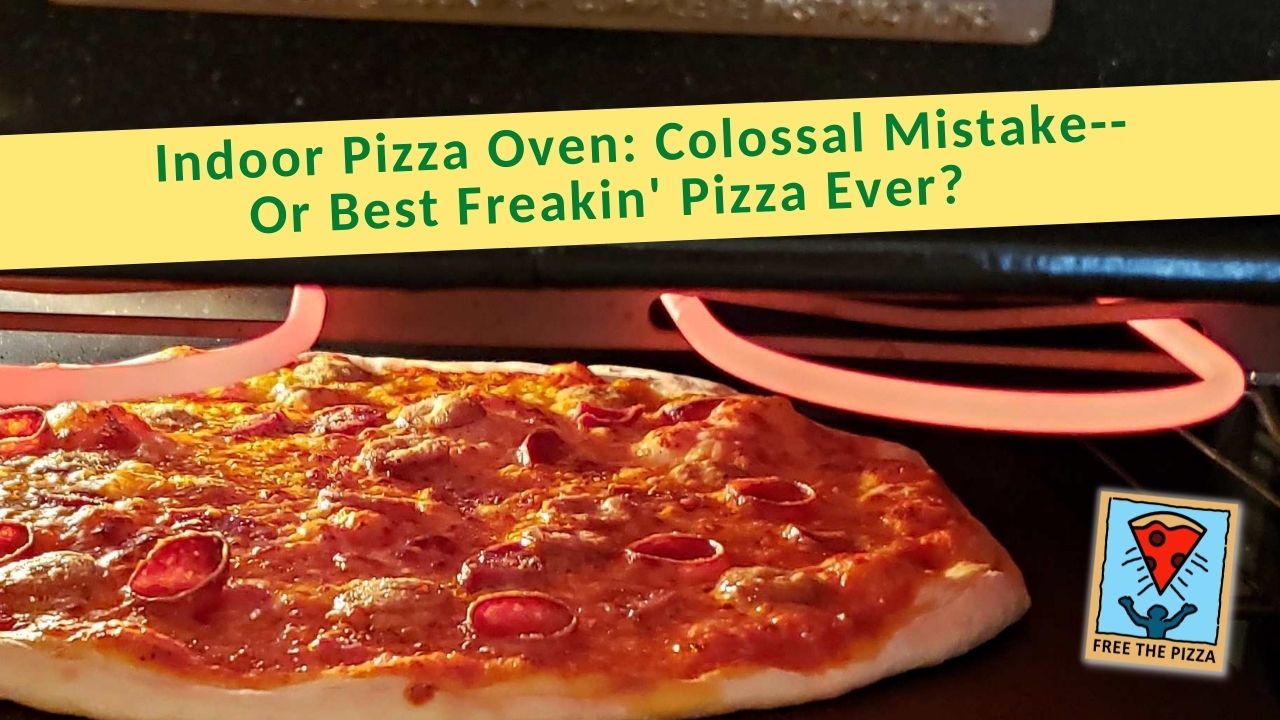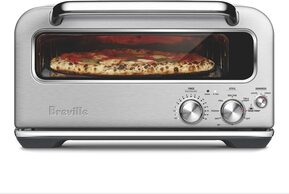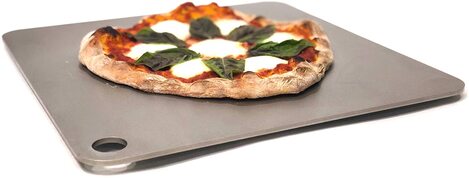Buying an indoor pizza oven: a colossal mistake--or the best freakin' pizza you ever had?7/22/2022 Someone on a Facebook pizza group recently asked for recommendations for an indoor pizza oven. Unleash the enthusiastic dogpiling! This oven! That oven! Another oven! Here’s a list of ovens from Google! Only one person commented not with an oven recommendation, but with a question: “Why an indoor pizza oven instead of just buying a steel?” Everybody else was jumping on with oven intel. But nobody was interested in qualifying the question. And “Why an oven?” was an important question, because this person said, “Please tell me more.” Of course, the person asking why was your Free The Pizza geek right here. The person seeking advice didn’t know there’s a simple way to turn a home oven into a pizza machine. The economics of an indoor pizza oven are questionable. The Breville Smart Oven Pizzaiolo (yes, a cumbersome name) is considered one of the best indoor ovens. It retails for about $1,000. It also makes a pizza that’s only 12 inches across. By all accounts, it's a pretty good oven. However... My preferred steel is a Thermichef, 3/8 inch thick, 16-inch square, and I can make any size pizza up to 16 inches (great for pizza parties) is under $180. It's also the steel you see in the image at the top of this blog post, being used in a cheap consumer oven in Maryland to make a pizza far better than any pizza available for takeout nearby. But I digress... There is so much pizza-oven madness out there that it diverts attention from a simple truth: you already own an oven that’s easily adapted to the task. “Oh, but a real pizza oven needs to reach 900 degrees!” That’s a lie. A “real” pizza oven needs to be hot enough to bake a pizza. What kind of pizza are you making? Did you know that a New York-style pizza is typically baked at 550 degrees? With that in mind, do you know what the maximum temperature setting is on many home ovens? 550 degrees. “But I want to make REAL pizza!” Well, ignoring the fact that New York-style pizza is as real as it gets for many people, there is no such culinary category as “real” pizza. But there is a category for Neapolitan pizza. That pizza comes from Naples, Italy. That kind of pizza has rules. One of those rules is about being baked in a 900-degree wood-fired oven. Save your money and your sanity. There few good reasons to go there until you’ve been making enough pizza that you can call yourself proficient. The smart money for freeing your inner pizza starts at a lower limit. I like to make 16-inch pizzas for groups of friends. That’s usually four or five pizzas over the course of an hour or so. That requires consistent heat and a big enough baking surface. That’s why I use 3/8-inch thick, 16-inch steel I described earlier. It stays hot enough over an hour to bake four or five pizzas. It fits in a standard home oven that has no convection fan. I’ve used it across the country to make pizzas in other people’s ovens. It’s great. But before you buy one, you have to measure your oven. This steel doesn’t fit in a lot of convection ovens. The door won’t close all the way. That’s why I also have the same 3/8 steel in a 14-inch version. Yes, I have two baking steels—which means I can use any standard home oven anywhere to make pizza. Those two steels right now cost about the same price as a hard to use, 12-inch, pellet-fired outdoor oven. Please know, I’m not dissing the dedicated pizza oven. They have their place and purpose. But for someone who’s interested in proficiency over purchases, the steel is simpler, more useful, and allows the greatest amount of flexibility. Right now, we’re on an extended road trip, and by the time we get home, I’ll have made pizza in five different states. That’s in New Jersey (three times), New Hampshire (three times), Rhode Island (twice), Massachusetts and South Carolina, if you care. It’s fun and people love it when the pizza wagon rolls up. It looks a lot like a small, gray, gently used SUV. But the guy driving has a bunch of simple tools that make pizza possible in any home oven. (That’s in the US. Pizzas abroad may vary.) If you’re truly interested in bringing the pizza joy, you’ll want other tools that make the job easier. And if you haven’t sunk hundreds or thousands into an indoor pizza oven and bought steel instead, there are funds left over for peels and pans and a cutter. Those things make pizza easier. A wood peel for launching the pizza, a metal peel for turning and retrieving the pizza, a metal pan for serving the pizza, and a cutter for (yes) cutting the pizza. But the most important part after making the dough is having the hot, hot, hot thermal mass required to make a pizza pop. High heat is the one thing that people usually lack. I’ve seen online “gurus” recommending that you bake a pizza at 350 degrees. The resulting pizza is not likely to make you happy. It could put you off baking pizza for good. If you can wrangle the necessary thermal mass to deliver as much heat as possible, you are on your way to becoming everyone’s favorite pizza maker. That’s my advice. That’s how I began the pizza journey. A steel and a wooden peel are a great way to start. Adding the other tools are great. But it all begins with thermodynamics. Physics is a powerful ally. And no half-baked recipe can fool science. If you'd like to see more of my preferred pizza tools, you can visit the Pizza Tools page at the website. Free the pizza!
0 Comments
Leave a Reply. |
AuthorBlaine Parker is the award-winning author of the bestselling, unusual and amusing how-to pizza book, Free The Pizza. Also known as The Pizza Geek and "Hey, Pizza Man!", Blaine is fanatical about the idea that true, pro-quality pizza can be made at home. His home. Your home. Anyone's home. After 20 years of honing his craft and making pizza in standard consumer ovens across the nation, he's sharing what he's learned with home cooks like you. Are you ready to pizza? Archives
July 2024
Categories
All
|
© Copyright 2021, 2022, 2023, 2024. All rights reserved.
As a ShareASale Affiliate and an Amazon Associate, we earn a small percentage from qualifying Amazon purchases at no additional cost to you.
When you click those links to Amazon (and a few other sites we work with), and you buy something, you are helping this website stay afloat, and you're helping us have many more glorious photographs of impressive pizza.
When you click those links to Amazon (and a few other sites we work with), and you buy something, you are helping this website stay afloat, and you're helping us have many more glorious photographs of impressive pizza.




 RSS Feed
RSS Feed